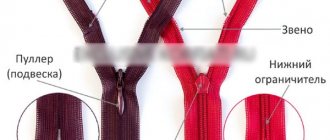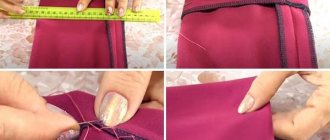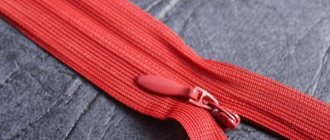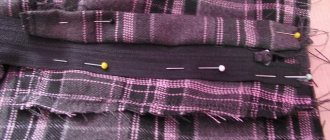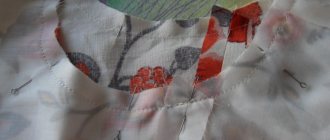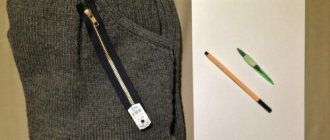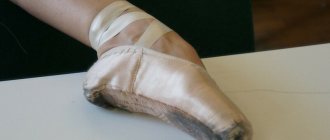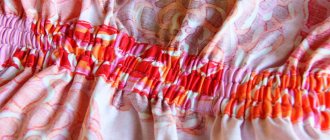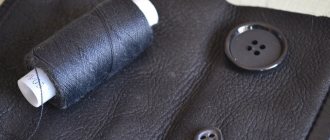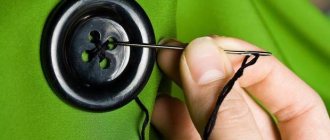Most often, a hidden zipper is used as a skirt fastener, but sometimes it needs to be installed in the side seam of a dress. Moreover, if on a skirt it can be almost imperceptibly “hidden” in the side seam, then when sewing a dress it is often installed not only on the side, but also on the back of the product, in the most visible place, and even up to 50 cm long. Therefore, you definitely need to learn how to sew a hidden fastener correctly and accurately, otherwise you can ruin all your work.
Let's look at what you need to consider to sew a hidden zipper on your skirt neatly and beautifully. These tips will also come in handy when installing a zipper on a dress.
This video shows how to sew a hidden zipper using a special foot.
Hidden zipper device
A hidden invisible zipper is the best fastener option in all cases where it needs to be made invisible. It is used when sewing clothes from light fabrics, such as skirts. It differs from its “visible” analogues in the location of the teeth on the reverse side of the tape. The hidden zipper is softer and more elastic.
Structurally, it consists of the following elements:
- textile tape (base) with sealed top and bottom edges;
- plastic links attached to the tape;
- slider (dog, slider) connecting and disconnecting links;
- keychain (pendant) – a part of a zipper lock that facilitates its use and fixation;
- lower and upper slider stops.
For the manufacture of hidden zippers, plastic (links, lock) is usually used; models with metal locks are less common. The most popular material for base tape is nylon, which is soft, durable, and flexible.
How to choose a zipper for a product
- For windbreakers, raincoats, and a dress made of thin fabric, a model made of plastic and synthetics will go well. It is flexible, lightweight, not afraid of moisture, and does not corrode like untreated metal.
- It is better to sew metal varieties into heavy, warm clothes, jeans, things for outdoor activities or sports. They are more durable, the teeth reliably “hold” each other and withstand increased tension.
- Hidden zipper. A model with small parts, usually made of plastic/synthetic materials, it is used where deliberately noticeable locks are undesirable.
A secret version of the lock is often introduced into women's clothing. It is with this that craftsmen have more difficulties when sewing. The main problem is to make it truly invisible, as it should be, based on the name. To do this, the element is placed in a seam, which is assumed by the design of the product.
premera74.ru
Selection criteria and types of hidden zippers
When purchasing a hidden zipper, you need to keep in mind that they all differ in several ways.
When choosing the right option, you should rely on the following criteria:
| Criterion | Description |
| Zipper length | Selected depending on the desired length of the fastener. There is a simple rule: the length of the zipper should be 2 cm longer than the length of the cut into which it will be sewn. The smallest length for a hidden zipper is 12 cm, the longest is not limited: there are also zippers of 1.5 m. If the zipper is needed there is no length, it is allowed to use an additional bracket that replaces the lower clamp. The staple is installed on the zipper in the selected location, after which the rest of it is cut off. |
| Link type | According to this parameter, lightning is divided into: · spiral (twisted). The links are formed from fishing line that is twisted into a spiral, flattened and secured to the braid. Spiral links give the zipper flexibility; they are more durable and resistant to bending, but they fail faster as the fastening gradually peels off and the spiral moves away from the base. Another drawback is the fear of high temperatures: if carelessly ironed with a hot iron, the spiral can melt and become deformed; · tractor (traditional). In such a zipper, each link is a U-shaped tiny part, independently attached to a nylon tape. This type of zipper has less flexibility, but the loss of one link does not affect the functionality of the fastener. If the damaged area is located below, then it can be repaired by installing an additional fastener. |
| Link size | Usually indicated by a number corresponding to the width of the locking strip in millimeters in a closed fastener. The higher this parameter, the more reliable the adhesion of the links, the greater the load the lightning can withstand. The choice of the optimal option depends on the thickness of the fabric on which the snake will be installed: the thinner it is, the smaller the size of the links should be. |
| Slider view | The main differences between zipper sliders are the locking mechanism. Based on this feature, lightning locks are divided into: · haberdashery (indicated by the abbreviation N/L) – do not have a locking mechanism. While the zipper is new, it is kept closed solely by friction, but later, as the teeth wear out, its behavior becomes unpredictable; · semi-automatic (P/L) – due to the presence of a special spike, they fix the clasp in the fastened state when the lock tongue is lowered down; · automatic machines (A/L) – capable of locking the lock not only at the top, but also in any other position. For a skirt, using a haberdashery lock, which can spontaneously open at any time, is undesirable. At the same time, the capabilities of the automatic lock are unlikely to be fully used. The best option is a semi-automatic. Also, when purchasing, you should pay attention to the lock pendant, which can have different configurations and sizes. A prerequisite: it must be strong enough, of a comfortable shape, hold well in the lock's shackle, and be easy to turn up and down. |
| Tape density | This parameter is measured in g/m2. The higher the density, the more reliable and durable the zipper. At the same time, high density makes the fastener too rigid, which is undesirable for clothes made of delicate fabrics. |
| Lightning color | The invisible zipper should have a color that is closest to the color of the product into which it will be sewn, or if there are 2-3 or more colors, match one of them. A twisted zipper provides more options in choosing colors, since the plastic line from which its teeth are created can be given almost any shade. |
| Zipper quality | A poor-quality clasp can ruin an otherwise ideal item and the mood of its owner. To prevent this from happening, when purchasing you need to make sure that: · the slider moves smoothly, without jerking, does not jam and does not leave open areas; · the lock is securely fixed in the closed state, and opens easily; · the links are located evenly, strictly at right angles to the edge of the base braid, at the same distance from each other, and are held firmly on the tape; · the tape is uniform in color, thickness and density, has neat, carefully sealed edges; · the links, when fastened, form an even strip running strictly in the middle of the base tape; · the zipper is absolutely smooth, has no sharp elements that could cause injury, and does not bend in “waves.” The following functions are not needed in a skirt zipper: · the presence of water-repellent impregnation, thanks to which the zipper fabric does not allow moisture to pass through; · detachable zipper – completely divided into 2 halves; · reverse – zippers with reverse are 2-sided, that is, the slider can be moved to the wrong side; · double slider – the presence of 2 sliders makes it possible to open the zipper from both the top and bottom. |
| Manufacturer | A low-quality zipper, even if it has successfully passed testing, may, after working for some time, begin to jam, unzip without permission, lose its “teeth” or even fail due to a rupture of the base tape or a broken slider. To avoid such a situation, it is advisable to purchase Japanese zippers (with YKK marking on the tongue) or Swiss (RIRI). They are considered leaders in the production of fasteners of this type; they will cost more, but will last much longer than the cheap Chinese counterpart. Alyzip , which produces zippers of all types, has proven itself well |
Materials and tools
The hidden zipper should be sewn onto the skirt correctly.
To do this, in addition to the zipper itself, you will need to prepare tools and materials that will help with the work and make it possible to complete it as carefully as possible:
- special foot for a sewing machine;
- threads to baste the zipper and then sew it in;
- scissors;
- tailor's chalk and ruler, with which you can mark the position of the zipper;
- centimeter tape - to take all necessary measurements;
- single sided adhesive tape.
The use of adhesive tape is mandatory if the zipper is sewn into a knitted product, into a piece cut with a bias cut, or used on very thin fabric, since it will prevent it from stretching and will help sew the zipper evenly, without distortions.
In the absence of adhesive tape, the material will inevitably be pulled by the foot, and then shrink, forming unsightly folds and a zipper. The second function of adhesive tape is to prevent the edges of the fabric from fraying.
What you need for sewing
For the stitching operation you will need the following materials:
- cut parts;
- the zipper itself (its length should be 3-5 cm longer than the seam into which it is sewn);
- threads (color must match the fabric and zipper);
- interlining for sizing.
Additionally, prepare sewing pins, chalk, overlock, and a tailor's ruler.
The slightest imperfection or inaccuracy in a self-sewn item will immediately catch your eye.
What is special about the concealed zipper foot?
You can only sew a hidden zipper to a skirt using a special foot.
How to sew a hidden zipper to a skirt? To do this you will need a special machine foot.
There are several varieties:
| Presser foot type | Description |
| Universal double-sided | It is designed to work with regular zippers, and produces a stitch spaced 2-3 mm from the lock seam. If you want to make the seam narrower, you need to bend the edges of the links with your fingers. This will require some experience, without which the seam will be uneven. |
| Single-sided or carob | It allows you to get closer to the links, but has a significant drawback: one side of the zipper is sewn from top to bottom, and the other from bottom to top. This can cause the fabric (especially thin or knitted fabrics) to shift and cause unsightly wrinkles near the zipper. |
| "Boat" | A Chinese product of appropriate quality: according to customer reviews, it does not fulfill its functions and only complicates the work. |
| Specialized foot for sewing in a hidden zipper | It has 2 grooves on the sole, one of which is designed to fix the right side of the zipper, the other - the left. Depending on which side is sewn, one or the other groove is used. The foot itself performs all the necessary operations (fixes the zipper and bends its links), thanks to which even an inexperienced seamstress gets an even, beautiful stitch located as close as possible to the links. Today it is the best option. |
When purchasing a specialized foot, you must take into account that they may also differ:
- by material of manufacture: metal and plastic. Provided that high-quality plastic is used, they are equivalent;
- according to the method of fastening: each foot is designed to work on a specific model of sewing machine. There are also products with a universal installation mechanism.
Preparing for work
You can sew a hidden zipper to the skirt to the seams of the product - side or back. If they are missing, you will need to make an incision in the tissue.
Before sewing a zipper, you must perform the following operations:
- Finish the seam (cut edges) using an overlocker.
- Iron the area of fabric on which the fastener will be sewn. If the fabric is prone to shrinkage, it is recommended to pre-wet it.
- Iron the zipper. If its base is cotton tape, then it is also recommended to first moisten (decate) it.
- In areas of future seams, glue the fabric (thin, knitted, fraying) with one-sided adhesive tape.
- If the zipper will not be inserted into a seam, then it is recommended to first glue the desired section of the fabric, and then mark and make the cut: this way it will turn out more even and neat.
It is recommended for a beginning seamstress to first stitch the zipper to the seam using a regular foot, setting the longest stitch length: this seam is needed to prevent the zipper from moving and is subsequently removed.
If the preparation is completed, a specialized foot is installed on the machine and the sewing of the zipper begins.
Useful tips
If you sew the fastener unevenly, the product may warp, the fabric will wrinkle or stretch. Difficulties can also arise if the skirt has no seams. In this case, you need to make a cut 2-3 cm longer than the length of the fastener. Then you can follow the usual algorithm and sew up the remaining incision.
To properly sew both a hidden and a regular zipper, you need to follow the recommendations of experienced craftswomen. There are several nuances, failure to comply with which can lead to errors:
- If the skirt is made of knitwear or delicate material, then between the zipper and the fabric there must be a lining - non-woven or double-lined.
- For knitted fabric, it is better to use special needles with a rounded tip. You need to make sure that the edge does not protrude beyond the teeth, otherwise the threads will get caught in them.
- Before sewing in a hidden zipper, you need to secure it well with pins. To prevent it from moving during stitching, you should mark it with chalk.
- It is not recommended to use thick needles; they may leave marks.
- If you need to cut off the excess length of the snake, be sure to secure the edge of the teeth so that the slider does not jump off.
- Do not allow large seam allowances. It is best that the edge of the fabric matches the edge of the zipper base.
- If a metal fastener is sewn in, you need to retreat 5 mm from the edge. Its teeth must be completely visible, otherwise it will get stuck.
You need to sew on a secret lock as carefully and discreetly as possible. At the same time, it should move freely, not get stuck or cling to the fabric. If you follow the recommendations, everything will work out as it should.
Algorithm for sewing in hidden zippers for different models of skirts
The advantage of a hidden zipper is that it is invisible on the fabric. Skirts with them look like a single fabric and therefore professionals often use hidden zippers in their products. Sewing technology for different models has its own characteristics that you need to know.
With belt
You can sew a hidden zipper to the skirt when the product is almost ready, the side seams are stitched and the waistband is attached. All that remains is to connect everything by sewing in a hidden zipper so that it reaches the waist. Before sewing in such a zipper, you must first secure it with pins. For stitching, thin needles are used that do not leave marks on the fabric. Seam allowances should remain minimal.
It is ideal when the edges of the allowances coincide with the edge of the zipper tape. When using a metal fastener, it is better to make a 5 mm indentation from the edge to prevent fabric from getting into the teeth. If you use a regular zipper, you need to sew on a button, but it is much more beautiful to make an invisible connection.
To sew such a zipper onto a skirt with a belt, you must perform the following steps:
- Turn the waistband inside out, making a mark, 1mm away from the seam and leaving an allowance. The distance from the edge of the part to the mark should correspond to the width of the zipper. The free end of the belt is turned up and fixed in the desired position with pins. This will make the seam less thick, allowing the zipper to be sewn evenly.
- When working, the zipper chain should be facing the seamstress, and the edges of the braid, on the contrary, should be facing away from you. Then you need to unfasten the lock and turn one half to the other side.
- Place one of the halves on the fold of the waistband area and pin it with a pin at the same level or slightly lower. Then baste it to the product. The running stitch can be made at any level. At the same time, you need to remember that such a zipper is sewn to the front side and only then turned inward.
- After finishing basting, machine sew the seam. This is done using a special foot. You should work carefully so as not to catch the lock teeth. If this happens, the seam needs to be ripped out and redone.
- Once the zipper is sewn in to waist level, turn the skirt inside out and zip it up, making sure the ends of the zipper stay flush.
- Bring the line to the end. The ends of the braid are hidden in the belt. It turns out and is carefully swept away. Then you can blindstitch part of the belt to the skirt.
Without belt
This option is considered the simplest.
It is enough to do the following:
- Sew all the details of the skirt, and make marks to baste the fastener.
- After checking that the connection is correct, iron the resulting seam inward, placing the zipper with the key fob facing down and baste one part first. Then, closing the fastener, baste the 2nd part.
- After opening the zipper, check that the connection is correct. It is first stitched across, then the seam is smoothly drawn along the left side. At the end the slider goes down. The right side is stitched in the same way.
- Hem and finish the top edge. The braid from the fastener is hidden under the hem of the belt or simply processed together with the allowances using an overlocker.
In most cases, it will be more interesting if the lightning remains invisible. A hidden zipper would be the best option.
Its sewing is carried out as follows:
- The skirt is turned right side out so that the seam is in front of the eyes. A lock is applied to it by turning the key fob towards you. The zipper opens. One side of the tape is turned to the right side, joining the seam face to face.
- The free edge of the braid should extend slightly beyond the allowance of the product, the limiter should be in line with the top seam of the product. Having pinned, baste the seam in this position. After this it will be easy to sew it on.
- Sew the second segment by turning the skirt inside out. First, it is basted, and then, after checking the correct location, it is stitched. The top pieces are sewn along the waistline when the waistband seam is made.
No seams
A product that has no seams requires special treatment. The zipper is sewn into it at the first stage of work. This is necessary so that the threads of the fabric do not twist and the material itself lies flat. A special stitch is made for this waist area. Then, in the area of the back seam, marks are placed 2-2.5 cm above the location of the fastenings of the future zipper. The seam is sewn down to them immediately. After this, the remaining parts are basted and the seams are ironed, including folding the allowances for the zipper.
It is sewn as follows:
- Place the front side to the seam so that the keychain faces down. The top rivets are located near the waist seam.
- Use pins to pin the braid to the seams, making sure that it is positioned evenly and does not move.
- The seam is made close to the beginning of the teeth, leaving a small gap so that the thread does not catch on them when machine stitching.
- Having removed the basting from sewing the seams of the skirt itself, you need to unfasten the lock and lower the slider to the end of the seam.
- The zipper is attached.
With pleats
If the skirt has bow pleats, the zipper may be hidden in one of the seams. This works if the cut consists of 2 parts. When there is only one canvas, the fastener is made from masonry, the size of which is pre-calculated. For thin and flowing fabrics, it is better to choose the option when it will be in the side or back seam of the product. The main thing is that the seam itself gets inside the fold.
Lined
The main work is carried out as usual, depending on whether the products have a seam or no seam. The lining and skirt are then folded right sides together. The lining itself moves slightly to avoid getting caught in the zipper. After this seam, the lining is stitched to the sewn fastener by basting, departing from the edge 5 mm. With the 2nd seam it is stitched completely. This method is suitable for skirts made of dense material, such as jersey or drape, where there is often a lining.
The important stages of this work are:
- Pre-treatment of the edges of the lining.
- Correct basting with a skirt.
- Using a blind stitch for basting with the product and stitching to the zipper.
In open seam
To do this, the fastener is unfastened and placed with the front side on the skirt allowances. Having basted it, you need to align the upper edges of the zipper and the seam at the waist. Both edges are basted separately, starting from the top. Using a special presser foot, the seam is laid closer to the teeth. At the end, the lower segment of the seam under the zipper is sewn down. The allowances are ironed well, and the belt is sewn on top.
In closed seam
The peculiarity of this method is that the entire product is first sewn together and only the zipper opening remains open. It is sewn on at the very end. Those who are just beginning to master the secrets of sewing need to know the rules for sewing fasteners into any product. This will make them look neat, and when closing the zipper, the fabric will not get stuck in the teeth, threatening to tear the work. It is important not only to carry out the work correctly, but also to choose a fastener in accordance with the material and style of the skirt.
Sew a fastener into a skirt without a belt
If the skirt does not have a belt, then the zipper should be sewn tightly. Let's take a closer look at this process. The first step is to sew on a zipper, then take and bend the top edge of the textile product. It is necessary to hem the fabric on a machine and hide it under the fabric. It is worth noting that the teeth of the snake should be flush with the edge of the skirt.
We can say that there is nothing complicated in this work, but it is necessary that where the zipper ends, the seam is made carefully. You can install locks in different ways, either by machine or by hand.
